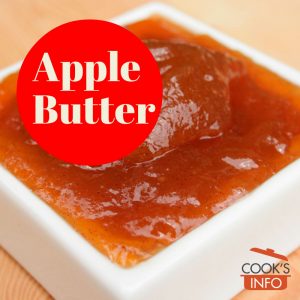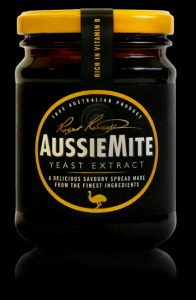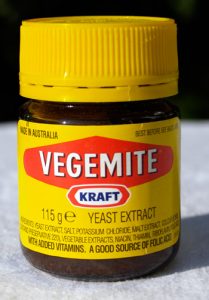Apple Butter © Denzil Green Apple Butter contains no actual butter. It is a thick fruit spread usually made from apples, apple juice or cider cooked down into a thick jam-like spread. It is flavoured with spices such as cinnamon, nutmeg or cloves, typically sweetened with large amounts of sugar, though sugar-free versions are also…
Spreads
Aussie Mite
Aussie Mite is an Australian yeast spread, made by All Natural Foods of Stirling, South Australia. The ingredients are: vegetable protein extract (corn), maltodextrin (tapioca), corn thickener (1401), sugar, sea salt, yeast extract, yeast, food acid (330), natural colour (caramel), niacin, riboflavin, thiamine, folate and water. There are no preservatives or artificial colouring used. (Ingredient…
Marmite Spread
Marmite is a thick, brown paste with a strong, salty flavour. It is the original yeast spread, made from yeast extract, salt, vegetable extract, and spices. It is sold in distinctive, bulb-shaped glasses with yellow lids. A French stock pot called a “marmite” is pictured on the label. It now comes in squeezable plastic jars…
Ozemite
Ozemite was an announced Australian version of Marmite. The product was planned and announced, but either did not hit the stores, or hit the store briefly for a period in 2001. Staff with Dick Smith Foods were themselves unclear and unable to confirm for us one way or the other. History Notes Ozemite was partly…
Promite
Promite is a yeast spread similar to Vegemite and Marmite. It is darker and sweeter than Vegemite, and a bit thinner than Vegemite and Marmite. It has less of a harsher salt taste than other yeast spreads. Ingredients include hydrolised vegetable protein extract, yeast extract, glucose, caramel colouring, wheat starch thickener, salt, lactose, vegetable gum,…
Spreads
In the food world, the term “Spreads” generally means “spreadable fats.” The fats can be vegetable or animal in origin. Though one might immediately think of butter or margarine when one thinks of spreads, there are also meat spreads, such as potted meats or potted shrimp. And there are confectionary ones, which are often chocolate…
Vegemite
Vegemite is a yeast spread, an Australian competitor to British-made Marmite. It is a very shiny, very dark, reddish, deep-brown spreadable paste. It is so thick that if you were to tip a jar up, it might take hours or days for it to run out of the jar. It is salty-tasting, but milder than…




